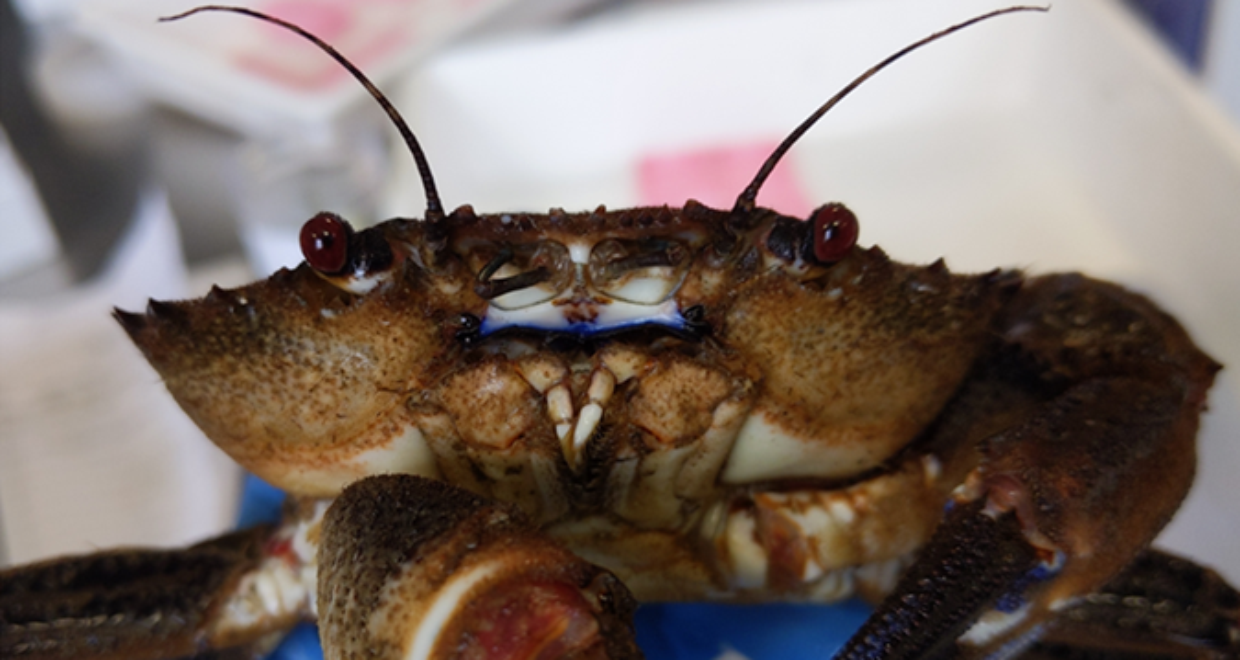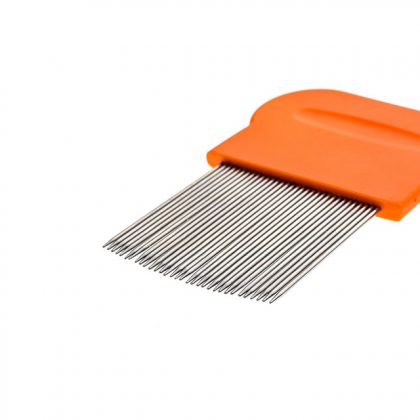Something to be crabby about?
Parasites can have serious impacts on their crustacean hosts and associated fisheries, from stunting growth to causing mass mortalities. When 56% of velvet crab from a bay in Ireland were found to be positive for the microparasite Paramarteilia sp., this was a cause for concern and warranted further investigation (Marine Institute, 2016). But let’s rewind a bit.
Velvet crab, nicknamed the devil crab perhaps due to their red eyes, are distinguishable by the covering of short hairs on their shell which give them a “velvety” feel to the touch. These swimming crab are an important commercial species, especially to smaller vessels in Ireland, and are a popular food in southern Europe. The most recent landings data for velvet crab in Ireland is from 2015, which really highlights how little we know about the stock. The same is true for other countries as well, where in Scotland the stock status is unknown. Despite a lack of information on landings, in 2016 an apparent decline in velvet crab catches was reported by fishers and as mentioned a high prevalence of microparasites was found. It was the first record of the protistan parasite Paramarteilia sp. in velvet crab and its effects on crab hosts remains largely unexplored. Other parasites have been able to affect velvet crab populations before, with declines in France being linked to a dinoflagellate parasite (Wilhelm & Mialhe, 1996).
The high prevalence of the parasite found in Ireland so far, combined with the little knowledge we have of the velvet crab stocks raised important questions I aim to answer. What proportion of velvet crab are infected, and what factors influence the parasite’s prevalence? Could season, crab size, and/or crab sex influence infection levels? How is the crab affected by the presence of this parasite? Following my recent work, I can begin to answer some of these questions. First of all, from 100 crab samples I have so far examined across 12 months, almost half of the crabs were infected with Paramarteilia sp. (Fig.2). It is clear that infection is higher at certain times of year, particularly in winter and spring (Fig. 3). Could this pattern possibly be due to the lifecycle of either the crab or the parasite? As parasite infections in crustaceans are sometimes linked to moulting (Eaton et al., 1991; Hamilton, Shaw, & Morritt, 2018). Yet another interesting avenue to explore with these parasites is that they are potentially vertically transmitted from parent to offspring, so we are also examining eggs from berried females to look for the parasites.
By continuing to work towards answering these questions we can start to understand more about the relationship between this parasite and its host, the devil crab, and determine if it is a parasite of concern in other crustacean species and whether it requires regular monitoring.

Figure 1. Velvet crab (Necora puber)

Figure 2. Velvet crab gill tissue: See the parasite Paramarteilia sp. circled

Figure 3. Seasonal prevalence of Paramarteilia sp. in velvet crab, Galway Bay
References:
Eaton, W. D., Love, D. C., Botelho, C., Meyers, T. R., Imamura, K., & Koeneman, T. (1991). Preliminary Results on the Seasonality and Life Cycle of the Parasitic Dinoflagellate Causing Bitter Crab Disease in Alaskan Tanner Crabs (Chionoecetes bairdi). In Journal of Invertebrate Pathology (Vol. 57). Retrieved from https://pdfs.semanticscholar.org/e47e/79c8ab397257f0ab872ef9a52287478296a5.pdf
Hamilton, K. M., Shaw, P. W., & Morritt, D. (2018). Prevalence and seasonality of Hematodinium (Alveolata: Syndinea) in a Scottish crustacean community. ICES Journal of Marine Science, 66, 1837–1845. Retrieved from http://search.proquest.com/asfa/docview/913748206/F5F1048E0B46B6PQ/11?accountid=14874
Morrissey, T., & Marine Institute. (2016). Nine month project evaluating the disease status of Velvet crab stocks with a focus on the prevalence of Paramarteilia sp . 1–22.
Wilhelm, G., & Mialhe, E. (1996). Dinoflagellate infection associated with the decline of Necora puber crab populations in France. Disease of Aquatic Organisms, 26(3), 213–219. https://doi.org/10.3354/dao026213
Author Biography

Signe Martin was awarded the 2021 Irish Society of Parasitology Prof. William C Campbell Postgraduate Award (sponsored by Cambridge University Press) for her talk on ‘An investigation of the disease status of velvet crab (Necora puber) in Galway Bay, with a focus on parasites’.
Signe is an Irish-Norwegian student in the third year of her PhD in Ireland at the Marine and Freshwater Research Centre, Galway-Mayo Institute of Technology. She became interested in the effects parasites and disease can have on marine species during her bachelor’s degree in Freshwater and Marine Biology. She is currently a Cullen Scholar on a Marine Institute funded project (2019-2023) in collaboration with Fish Vet Group and the University of Glasgow. Her project revolves around microparasites in crab, and using both histological and molecular techniques, aims to understand more about host-parasite relationships.






